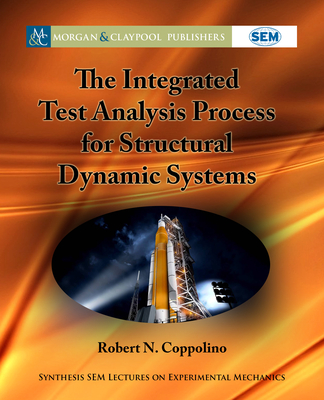The Integrated Test Analysis Process for Structural Dynamic Systems
暫譯: 結構動態系統的整合測試分析過程
Coppolino, Robert N., Zimmerman, Kristin B.
- 出版商: Morgan & Claypool
- 出版日期: 2019-11-15
- 售價: $2,900
- 貴賓價: 9.5 折 $2,755
- 語言: 英文
- 頁數: 164
- 裝訂: Hardcover - also called cloth, retail trade, or trade
- ISBN: 1681736837
- ISBN-13: 9781681736839
-
相關分類:
工程數學 Engineering-mathematics
海外代購書籍(需單獨結帳)
相關主題
商品描述
Over the past 60 years, the U.S. aerospace community has developed, refined, and standardized an integrated approach to structural dynamic model verification and validation.
One name for this overall approach is the Integrated Test Analysis Process (ITAP) for structural dynamic systems. ITAP consists of seven sequential tasks, namely: (1) definition of test article finite element models; (2) systematic modal test planning; (3) measured data acquisition; (4) measured data analysis; (5) experimental modal analysis; (6) systematic test-analysis correlation; and (7) reconciliation of finite element models and modal test data. Steps 1, 2, and 7 rely strictly on mathematical model disciplines, and steps 3 and 4 rely on laboratory disciplines and techniques. Current industry practice of steps 5 and 6 calls for interaction of mathematical model and laboratory disciplines, which compromises the objectivity of both modeling and laboratory disciplines. This book addresses technical content, strategies, and key relevant experiences related to all steps of ITAP, except for measured data acquisition which is the specialized domain of highly experienced laboratory professionals who contend with mechanical and electrical practicalities of instrumentation, excitation hardware, and data collection systems.
商品描述(中文翻譯)
在過去的60年中,美國航空航天界已經開發、完善並標準化了一種結構動態模型驗證和驗證的綜合方法。
這種整體方法的名稱之一是結構動態系統的綜合測試分析過程(Integrated Test Analysis Process,簡稱ITAP)。ITAP包含七個連續的任務,即:(1) 測試物件有限元素模型的定義;(2) 系統化的模態測試規劃;(3) 測量數據的獲取;(4) 測量數據的分析;(5) 實驗模態分析;(6) 系統化的測試-分析相關性;以及(7) 有限元素模型與模態測試數據的調和。步驟1、2和7嚴格依賴數學模型學科,而步驟3和4則依賴於實驗室學科和技術。目前行業在步驟5和6的做法要求數學模型與實驗室學科的互動,這會妨礙模型和實驗室學科的客觀性。本書針對ITAP所有步驟的技術內容、策略和關鍵相關經驗進行探討,唯獨不包括測量數據的獲取,因為這是高度經驗豐富的實驗室專業人員的專業領域,他們處理儀器、激勵硬體和數據收集系統的機械和電氣實務。
作者簡介
作者簡介(中文翻譯)
羅伯特·N·科波利諾(Robert N. Coppolino)在紐約市接受正式教育,畢業於斯圖伊文森高中(Stuyvesant High School),並獲得布魯克林理工學院(Polytechnic Institute of Brooklyn)航空工程學士學位(B.S. Aerospace Engineering),以及應用力學碩士(M.S.)和博士(Ph.D.)學位。作為格魯曼航空公司(Grumman Aerospace Corporation)的一名結構動力學工程師(1967-1975),他支持了登月模組、天宮(Skylab)和航天飛機(Space Shuttle)計畫,並為發射載具的彈跳(pogo)抑制技術和推進劑儲罐的水彈性建模及測試分析相關性開發做出了貢獻。1975年至1983年,科波利諾博士在航空公司(The Aerospace Corporation)工作,最終擔任工程動力學部門經理。在航空公司期間,他支持了NASA的航天飛機彈跳整合小組,開發了用於實驗模態分析的同時頻域(Simultaneous Frequency Domain, SFD)方法,並定義了創新的殘餘向量技術,這些技術成功應用於航天飛機非線性有效載荷介面飛行載荷預測及海上夾層平台結構損傷檢測。1983年至1987年,他擔任麥克尼爾-施文德公司(MacNeal-Schwendler Corporation, MSC)先進方法與開發部門經理。在MSC工作期間,他領導了一個由MSC、J.S. Bendat公司和Synergistic Technology Incorporated組成的聯盟,開發了最終被稱為整合測試分析過程(Integrated Test Analysis Process, ITAP)的技術。自1987年至今,科波利諾博士在測量分析公司(Measurement Analysis Corporation)擔任多個高級職位,目前擔任托倫斯業務的首席技術官(Chief Technology Officer)。在此期間,他與已故的朱利烏斯·S·本達特(Julius S. Bendat)密切合作,開發非線性系統識別的非線性頻譜技術。此外,科波利諾博士繼續開發ITAP組件,包括模態測試分析調和的高效程序。ITAP能力的完整套件於2001年在NASA/MSFC進行的國際空間站P5短間隔模態測試中首次實現了端到端的“黃金時段”應用。












